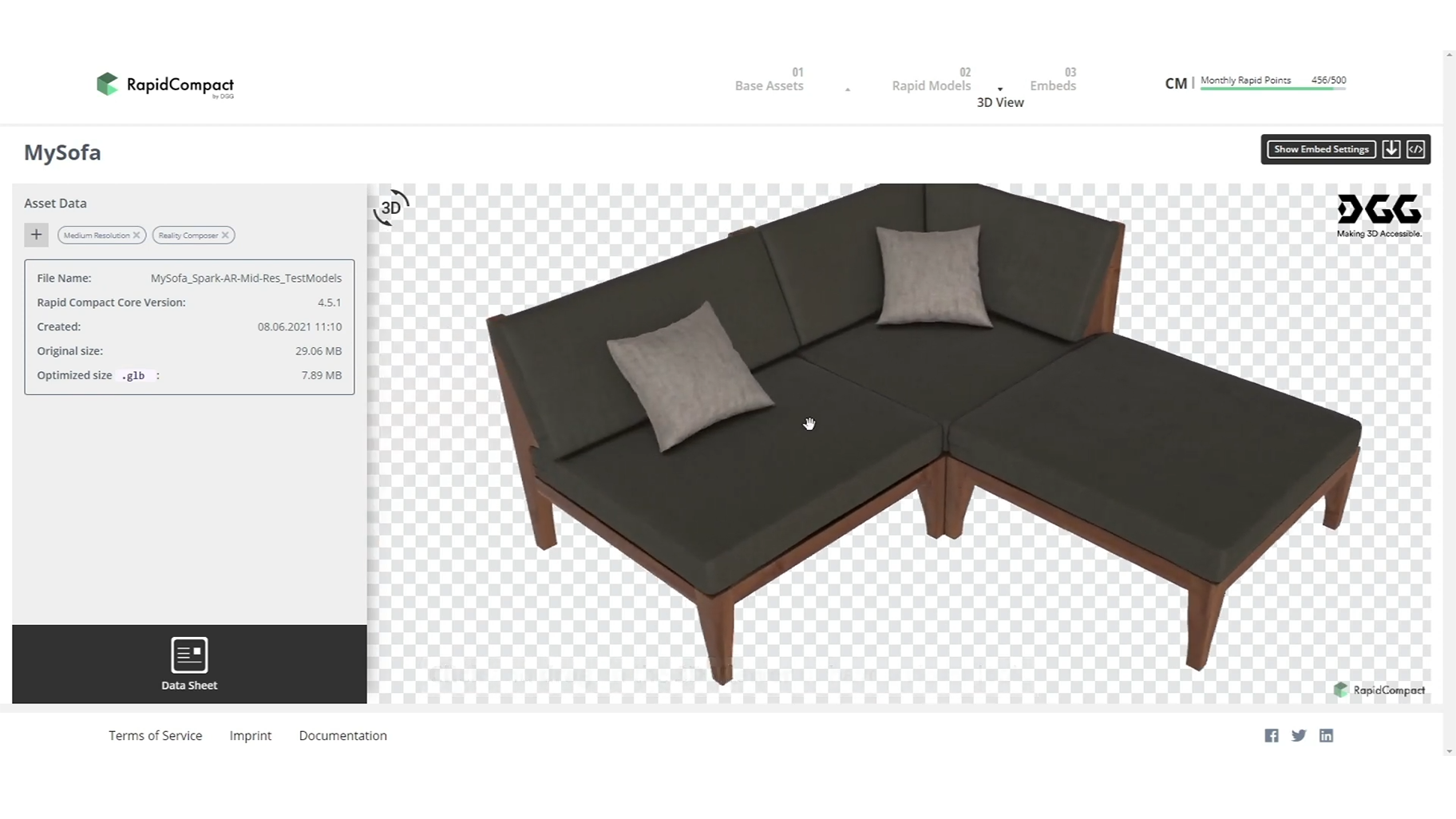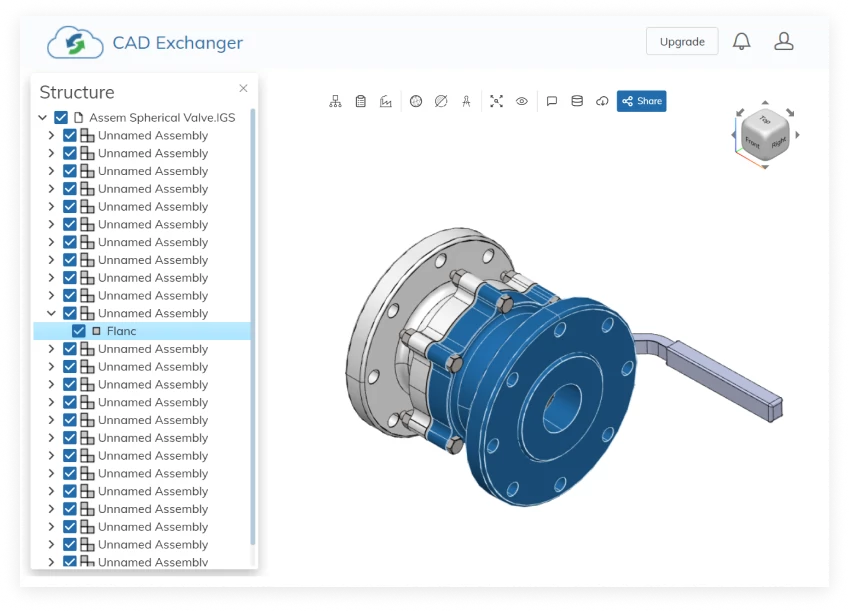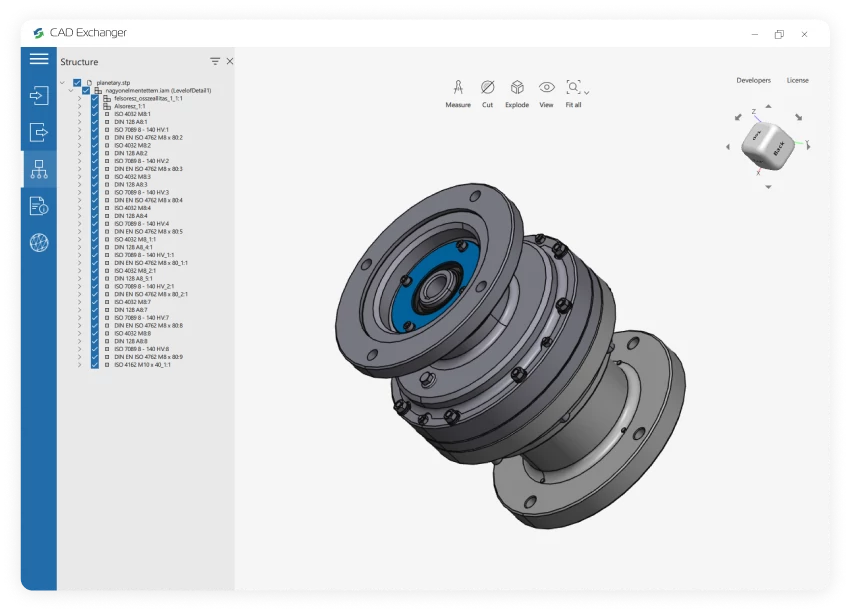

Conversion from OBJ to SOLIDWORKS is not supported yet :(
Learn more
OBJ
The OBJ format is a popular and widely used file format for representing 3D geometry. It was initially developed by Wavefront Technologies for their Advanced Visualizer software. OBJ files store information about the vertices, faces, texture coordinates, normals, and material properties of a 3D model.
This format supports the representation of polygonal geometry, making it versatile for a wide range of applications. OBJ files are widely supported by various 3D modeling, animation, and rendering software, making it easy to share and exchange 3D models across different platforms and workflows.
Support of OBJ files in CAD Exchanger
CAD Exchanger can import files with external .mtl (material library) files, files with both multiple and single parts, and export files. Such support includes:
- polygonal representations;
- colors, materials, textures.
Follow this link to check out all the CAD Exchanger products.
Pros of the format
Universality
One of the key advantages of this format is its widespread compatibility. OBJ files can be imported and exported by a vast number of 3D modeling, animation, and rendering software applications. This broad support allows for seamless collaboration between different software packages, making it easier to share 3D models across various platforms and workflows. Whether you're working with industry-standard software or niche tools, chances are high that they will support the OBJ format.
Simplicity
The OBJ format is known for its simplicity and ease of use. OBJ files are plain text files, making them human-readable and easily editable. This simplicity makes it straightforward to manually modify or create OBJ files using a basic text editor if needed. Additionally, the file structure of OBJ is relatively straightforward, consisting of vertices, faces, and associated information. This simplicity makes it accessible for beginners and allows for quick understanding and integration with other software pipelines.
Cons of the format
Limited Geometry Support
This format has some limitations when it comes to representing complex geometry. OBJ is actually a polygonal format, so B-Rep is not supported as a class, neither for a simple cylinder nor for super-complex geometry. As a result, OBJ is not suitable when there is a need for B-Rep, and not polygonal meshes. This can be a disadvantage when working with models that require precise curved surfaces or complex mathematical representations.
Lack of Animation and Rigging Data
Another drawback of the OBJ format is that it does not inherently support animation or rigging data. OBJ files primarily focus on static 3D geometry representation and lack the ability to store information related to skeletal animation, rigging, and dynamic simulations. It also lacks several features like support for lights, LOD settings, and advanced materials. This makes it less suitable for complex animated scenes or character animations that require bone structures, joint deformations, or motion data.
FAQ
Is OBJ format specification publicly available?
Yes, it is. The OBJ file format specification defines the structure and organization of OBJ files. OBJ files begin with a list of vertex data, which consists of coordinates (X, Y, Z) that define the geometry of the 3D model. Texture coordinates (U, V) can also be included to map textures onto the model's surfaces. Normal vectors (X, Y, Z) define the orientation of the surfaces.
Faces are defined using indices that reference the previously defined vertices, texture coordinates, and normals. Groups and smoothing can be specified to organize the model's faces and define the shading and smoothness of adjacent faces. Additionally, OBJ files can reference material libraries (MTL files) that define properties like color, reflection, and transparency for the model's surfaces.
What are the typical .obj file extensions?
The OBJ file format is usually associated with two file extensions: .obj and .mtl.
.obj is the primary extension for OBJ files. It represents the 3D geometry data, including vertex coordinates, texture coordinates, normal vectors, and face definitions. The .obj file contains the essential information required to represent the shape and structure of the 3D model.
.mtl is a companion file to the OBJ format. It contains information about the material properties applied to the surfaces of the 3D model, such as color, reflectivity, transparency, and textures. The .mtl file is referenced by the OBJ file to assign materials to different parts of the model.
How to open a .obj file?
To open this file, you will need a compatible software application, for example, CAD Exchanger Lab. Launch the software and navigate to the 'New file' option. Browse your computer's directories and locate the .obj file you want to open. Then select it and click "Open". Once the import process is complete, the .obj file should be loaded into the software, allowing you to view and interact with the 3D model and associated data.
History of the OBJ format
The OBJ file format has a rich history in the field of computer graphics. It was originally developed by Wavefront Technologies, a company known for its pioneering work in 3D computer graphics and animation software. The OBJ format was first introduced in the late 1980s as part of Wavefront's Advanced Visualizer software, which was widely used in the film and entertainment industry.
Wavefront designed the OBJ format to provide a standard way to exchange 3D models between different software applications. It aimed to address the interoperability challenges that arose due to the diverse range of 3D modeling and animation software available at the time.
As the OBJ format gained popularity, it became widely adopted by the computer graphics community. Its simplicity, versatility, and support for geometry, texture, and material data made it a favored choice for sharing 3D models across various platforms and software packages.
The OBJ format has been embraced by numerous 3D software applications, making it a de facto standard for exchanging 3D models. Despite the emergence of newer formats, OBJ remains widely used and supported due to its long-standing history, compatibility, and ease of integration into different workflows. Today, the OBJ format continues to play a significant role in the world of 3D computer graphics.
SOLIDWORKS
SOLIDWORKS is a proprietary format, used by the SOLIDWORKS software, a professional 3D CAD software application. It utilizes the file extensions ".sldprt" for part files and ".sldasm" for assembly files. In this format, all the necessary geometric information, features, dimensions, constraints, and other design data are stored to represent and document a 3D model.
Support of SOLIDWORKS in CAD Exchanger
CAD Exchanger can read files from version 2004 to version 2025. Such support includes:
- B-Rep representations;
- polygonal representations (except for versions 2004, 2007, and 2008);
- assembly structure via external files;
- configurations;
- names;
- user-defined properties;
- graphical PMI (versions 2015-2022);
- colors.
Follow this link to check out all the CAD Exchanger products.
Pros of the format
Comprehensive design information
The SOLIDWORKS format contains comprehensive design information. It includes not only the 3D geometry of the part or assembly but also feature history, dimensions, constraints, materials, and other design parameters. This level of detail allows for easy modification, analysis, and collaboration within the SOLIDWORKS ecosystem.
Widely used in engineering and manufacturing
SOLIDWORKS is a widely adopted CAD software, and its proprietary format is supported by various CAD tools, engineering applications, and manufacturing processes. This compatibility ensures seamless data exchange and collaboration between different stakeholders, such as designers, engineers, and manufacturers. Using the SOLIDWORKS format facilitates effective communication and streamlines the workflow throughout the product development lifecycle.
Cons of the format
Proprietary Format
The SOLIDWORKS format is proprietary, meaning it is owned and controlled by Dassault Systèmes, the company behind SolidWorks. As we wrote above, this format is widely used in engineering and manufacturing, but there are still softwares and tools that do not support SOLIDWORKS, due to its proprietary nature. While SolidWorks does provide options to export to various standard formats like STEP or IGES, the main challenge is that neutral formats do not contain all the design information, but only the final result of the design process. Also, there may be challenges in maintaining full fidelity and compatibility when working with other CAD systems.
Numerous ".sldprt" and ".sldasm" files
Managing a large number of files when working with complex models can become challenging, especially when it comes to transferring data. Some files can be lost or deliberately hidden. Without all the files together, the user only has an approximate model geometry in the form of a polygonal mesh, but all design information, including the exact geometry, is missing.
FAQ
What are SOLIDWORKS file extensions?
The file extension ".sldprt" is used for SOLIDWORKS part files. They are the building blocks of assemblies and are created and modified within the SOLIDWORKS environment.
For assembly files, SOLIDWORKS uses the ".sldasm" extension. Assembly files represent the coming together of multiple parts into a larger, functional unit. They are essential for visualizing and analyzing the interaction between different components.
Drawing files in SOLIDWORKS have the ".slddrw" extension. These files contain 2D representations of parts or assemblies. They enable the generation of design documentation suitable for further usage in product lifecycle, in particular they serve as blueprints for creating physical parts.
SOLIDWORKS also utilizes template files for creating new documents. Template files have the extensions ".prtdot" for part templates and ".asmdot" for assembly templates. These files define the default settings, styles, formats, and other parameters for creating a new part or assembly documents.
Additionally, SOLIDWORKS features a library feature functionality that allows users to create reusable design elements. Feature files for library features use the ".sldlfp" extension. These files define specific features that can be applied to parts or assemblies, saving time and effort by enabling the reuse of complex or commonly used design elements.
How to open SOLIDWORKS file?
To open this file, you will need a compatible software application, for example, CAD Exchanger Lab. Launch the software and navigate to the 'New file' option. Browse your computer's directories and locate the file you want to open. Then select it and click "Open". Once the import process is complete, the file should be loaded into the software, allowing you to view and interact with the 3D model and associated data.
History of SOLIDWORKS format
The SOLIDWORKS format history dates back to the early 1990s when SolidWorks brand was founded by Jon Hirschtick. The goal was to create a user-friendly, parametric 3D modeling software that would revolutionize the CAD industry.
In 1995, the first version of SOLIDWORKS was released, introducing a groundbreaking approach to 3D modeling. As SOLIDWORKS gained popularity, it expanded its capabilities and introduced new features with each subsequent release. The software focused on improving design efficiency, accuracy, and collaboration.
In 1997, Dassault Systèmes, a renowned software company, acquired SolidWorks Corporation, bringing SOLIDWORKS into its product portfolio. The SOLIDWORKS format has become a standard in the CAD industry.
Today, SOLIDWORKS remains one of the most widely used CAD software packages, serving millions of users worldwide. Its continuous development, integration with other technologies, and commitment to user-friendly design have solidified its position as a leading CAD solution in the industry.
From Our Blog

Everything you need to know about CAD file formats
A CAD file is an output of a CAD software, containing key information about the designed object: its geometry and topology representation, 3D model hierarchy, metadata, and visual attributes depending on the format of the file.
Read more
3D formats overview: OBJ
In the ninth part of the series, we take a look at the effectively standard format for 3D graphics
Read more
Darmstadt Graphics Group GmbH brings CAD to AR applications with CAD Exchanger SDK
CAD Exchanger imports and tesselates FBX, glTF, OBJ, PLY, and STL files, making them ready for further optimization by RapidCompact.
Read more
